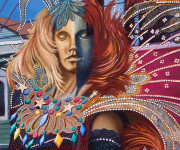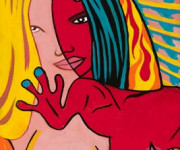Pop Art
Pop Art is an art movement that emerged in the late 1950’s and gained momentum in the 1960’s. Pop art presented a challenge to traditions of fine art by including imagery from popular and mass culture.
Product labeling and logos figure prominently in the imagery chosen by pop artists.
Pop Art is widely interpreted as a reaction to the then-dominant ideas of Abstract Expressionism and was aimed to employ images of popular as opposed to elitist culture in art. Artists were inspired by the experience of living within that culture.
Pop Art marked a return to hard-edged composition and representational art as opposed to the “painterly looseness” of Abstract Expressionism.
Famous Pop Artist, Andy Warhol made extensive use of film star imagery such as Marilyn Monroe , Elizabeth Taylor and Marlon Brando.
As a full-fledged art movement, Photo-realism evolved from Pop Art and as a counter to Abstract Expressionism as well as Minimalist art movements in the late 1960’s and early 1970’s. Photorealism is also sometimes labeled as Super-Realism, New Realism, Sharp Focus Realism, or Hyper-Realism.
Photo-realists were trying to reclaim and exalt the value of an image. Change and movement is frozen in time and then accurately represented by the artist. This results in the photorealist style being tight and precise.
Photorealists gather their imagery with a camera, systematically transfering the image from the photograph onto a canvas. Usually this is done either by projecting the image or by using traditional grid techniques.
Photo-realists and pop artists gathered their information from popular culture. Richard Estes, Tom Blackwell and Don Eddy did many paintings of images found on New York City streets – store windows with reflections of motorcycles, cars and mannequins.
Tattoo Art has become another form of Pop Art – a unique subculture. The work of pop artists such as Andy Warhol, Roy Lichtenstein and Keith Haring have found their way into Tattoo culture.



